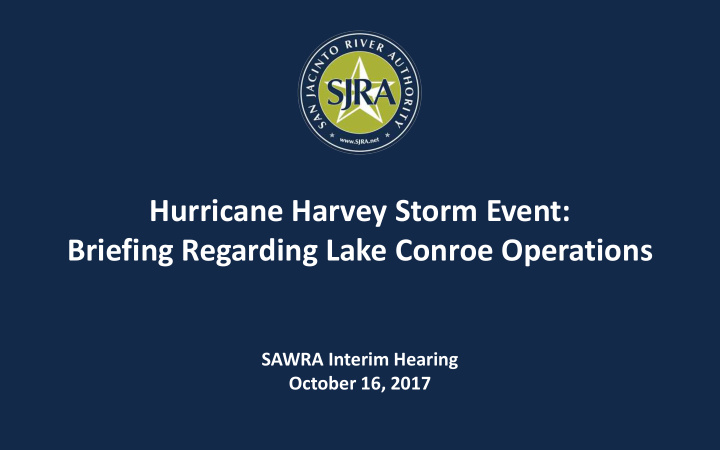



Hurricane Harvey Storm Event: Briefing Regarding Lake Conroe Operations SAWRA Interim Hearing October 16, 2017
Key Point #1 – There’s No Option to Simply Hold Water and Not Release • Lake Conroe is a water supply reservoir • Designed to stay near full • Designed to pass inflows from storms • Very limited freeboard to capture inflows • Structurally, the gates must open as lake rises
Top of Tainter Gate 18” Freeboard Top of Water Surface Upstream side Downstream side of Tainter Gate of Tainter Gate
Normal Pool, Closed Gates Rising Water, Open Gates Lake Freeboard Level 18” Freeboard Normal Lake Level Tainter Gate Lake Discharge Ogee Weir Ogee Weir
Key Point #2 – Lake Conroe REDUCES downstream flooding • Even though a water supply reservoir, Lake Conroe reduces peak flow through lake • Possible due to six-foot flowage easement or inundation zone • Operating protocol balances inflow reduction and lake level rise
Peak Flow Into ~130,000 cfs Lake Conroe Water detained in Discharge from Lake Conroe Lake Conroe Flow at I-45
Key Point #3 – Lake Conroe level remained within authorized flowage easement • Six-foot flowage easement acquired when lake was constructed • Recorded in deed records • Authorizes inundation up to 207’ msl • During Harvey, peak elevation was 206.24’ msl
Flowage easement
Permanent Flowage Easement Elev = 207.00 Normal Water Surface Elev = 201.00
Key Point #4 – SJRA does not pre-release prior to storm events • Primary reason – high risk of making downstream flooding problems worse • It would take weeks to safely lower Lake Conroe any significant amount • Small increase in storage makes no difference in large storm event like Harvey • Weather predictions not accurate enough
Time required to safely lower Lake Conroe Retained daily rainfall Daily Volume Daily Reduction Release Rate for entire watershed Released in Lake Level assuming 50% (cfs) (acre-feet) (inches) infiltration (inches) 625 1,250 0.75 0.1 1,250 2,500 1.5 0.2 2,500 5,000 3 0.4
Saturday, August 19, 2017 - 6 Days Prior to Landfall Storm dissipated from forecasts six days from ultimate landfall. August 22 (three days from landfall), NWS announced: - “remnants of Harvey centered over Yucatan.” - “likely to redevelop into a tropical storm or hurricane over the warm waters of the Bay of Campeche.”
One day before landfall, heavier rainfall projected downstream of Lake Conroe Thursday
Interim Charge #1 – Communicating Release Figures • Operational data, including releases, is currently available on SJRA website in real time • Montgomery County uses Smart 911 to push information to registered users • Investigating options for individuals to register for email/text alerts of changes at specific gauges – User-selected gauges – User-determined targets
Interim Charge #2 – Regional Flood Warning Systems • SJRA currently shares gauge data with Harris County Flood Control District • Users can go to one website and see gauges from HCFCD, TRA, SJRA, Fort Bend County, Sugar Land, Pearland, and TXDOT • Investigating options for counties, cities, and other agencies to expand partnership with HCFCD. – One-stop source for citizens throughout region. – Dense coverage of streams and bayous.
BACKUP SLIDES
Key Point #5 – Lake Conroe makes up roughly 10 to 20 percent of the flows into Lake Houston
Impact from Lake Conroe watershed: - Lake Houston = 10-20% - The Woodlands W of I-45 = 0% - Tomball = 0% - Woodforest = 0% - Cleveland = 0% - Plum Grove = 0% Jeff Lindner, HCFCD https://www.youtube.com/watch? v=SowuK0T41Rc
Recommend
More recommend